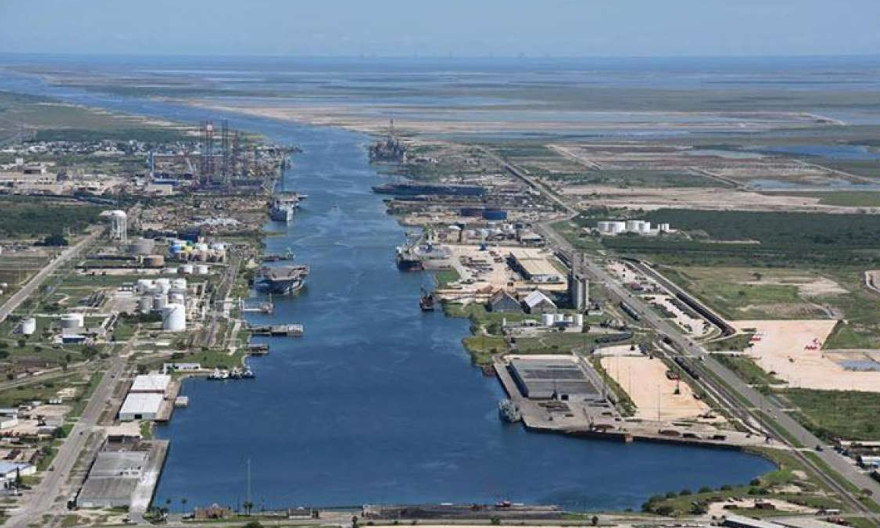
Cameron County commissioners on Tuesday approved a $373 million tax abatement deal for Houston liquefied natural gas company Annova LNG to build an export terminal at the Port of Brownsville.
Some 80 supporters and 50 opponents of the controversial LNG export project packed Cameron County Commissioners Court meeting. After hearing dozens of public comments from both sides, commissioners voted 3-2 in favor of the 10-year tax deal.
Under the agreement, Annova LNG will make a one-time payment of $5.5 million for community projects as well as 10 annual payments of $500,000 to the county in lieu of taxes. The deal holds as long at the company employs more than 100 people and ensures that at least 35 of them of them are local hires.
“We both have a vision for a better and brighter future for Cameron County,” Annova LNG CEO Omar Khayum told commissioners. “How do we deliver it? We create jobs. Sustainable, high-paying jobs.”
Annova LNG is one of three liquefied natural gas companies seeking to build export terminals in Brownsville. Annova’s project, which is awaiting approval from federal regulators, will produce and export up to 6 milion metric tons of LNG per year. But the project and those proposed by two other Houston companies — NextDecade and Texas LNG — face stiff opposition from a coalition of shrimpers, fishermen, environmentalists, neighbors and communities working under the banner Save RGV from LNG.
Citing environmental and safety concerns, opponents have vowed to continue the fight.
“By approving this terrible tax break deal, Cameron County commissioners failed their constituents who will bear the costs of Annova LNG’s polluting facility,” said Rebekah Hinojosa, a organizer for the Sierra Club, a national environmental advocacy group that is part of the coalition. “The communities of South Padre Island, Port Isabel, Laguna Vista, and Long Island Village, have all passed anti-LNG resolutions. Annova LNG would pollute Latinx communities and poses a huge environmental risk to the Rio Grande Valley.”
The tax abatement vote split the court with commissioners Sofia Benavides, Joey Lopez and Gus Ruiz voting in favor and Commissioner David Garza and County Judge Eddie Trevino Jr. voting against it. Two years earlier, the commission voted 4-1 in favor of giving a similar tax abatement to NextDecade.
Supporters of the tax break for Annova said the project will provide a needed boost to the local economy, creating 700 construction jobs over 54 months, representing $324 million in payroll. The Rio Grande Valley is one of the poorest areas in Texas.
But Maria Galassio, a resident of Laguna Vista and Save RGV From LNG member, said she was disappointed by the commissioner’s court. “I feel the Cameron County Commissioners Court dropped the ball again,” Galassio said in a statement.
Launched in 2013 and headquartered in Houston, Annova LNG is owned by a consortium of four companies. Chicago utility Exelon owns 80.55 percent while Enbridge, the Canadian pipeline company, holds a 10.5 percent stake. Nebraska engineering, procurement and construction firm Kiewit and Kansas energy technology firm Black & Veatch each own 4.475 percent.
Annova LNG has not sold contracts for any of its planned production. Khayum said the facility would need commitments from customers to buy about two-thirds of its annual production — 4 million of 6 million metric tons — before the company can make a final decision to go forward with the project.
Annova, NextDecade and Texas LNG are still waiting on federal permit decisions, but environmental reviews of the projects expressed concern about the cumulative traffic, noise and habitat fragmentation they would have on the endangered ocelot, jaguarundi and aplomado falcon if all three projects are built.
In an environmental review, regulators said concerns for Annova LNG as a single project could be overcome through the proper mitigation efforts. Annova LNG has pledged to use noise and pollution-reducing electric motors for its plant and to develop an 185-acre wildlife corridor. The company plans to build a concrete wall along the boundary of the wildlife corridor that will further reduce noise and light — and keep animals out of the plant.
Last month, Annova LNG went another step further and pledged get all 405 megawatts of electricity for its proposed export terminal from renewable sources such as wind and solar.
“When Annova LNG comes online, we will have the lowest carbon footprint of any U.S. LNG provider, and quite possibly the lowest carbon footprint of any LNG provider in the world,” Khayum told commissioners. “Annova LNG — and therefore Cameron County — will be a national and global leader in developing the sustainable jobs of the future. That is something we should all be proud of.”
This article first appeared on the Houston Chronicle – an Energy Voice content partner. For more from the Houston Chronicle click here.
Recommended for you
